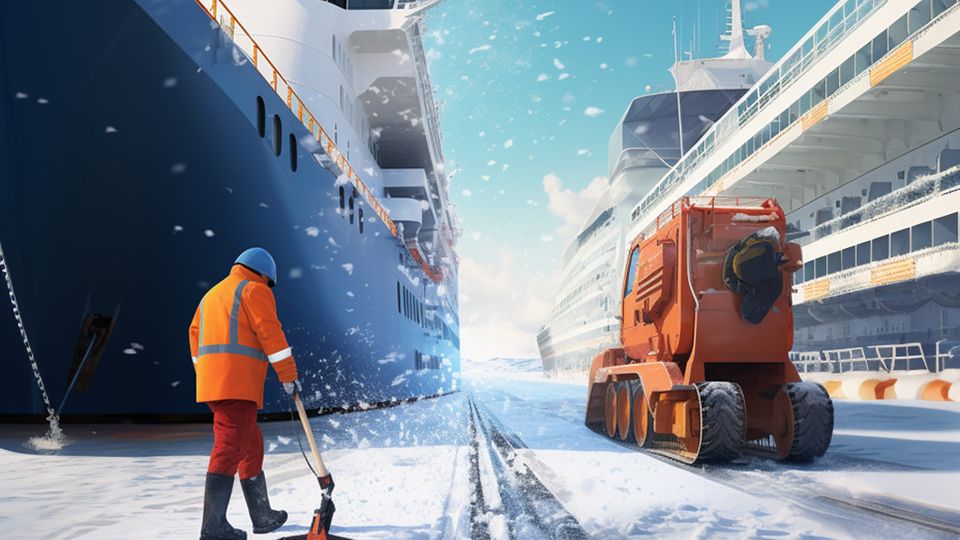What Causes Ice to Stick or Slip?
Scientists unravel the mysteries of ice that could help to reduce ice accretion on surfaces such as roads and aircraft

Complete the form below to unlock access to ALL audio articles.
It’s that time of the year again as plunging temperatures and heavy snow connive to upend Christmas plans while the United States gear up for one of its busiest travel weeks. Winter's icy grip leads to dangerously slippery roads and frequent flight delays as freezing conditions necessitate thorough de-icing. But what causes ice to stick or slip on surfaces? Reporting in the journal Materials Horizons, a multi-institutional study from the University of Illinois Chicago and Argonne National Laboratory takes the cold plunge into unraveling the many mysteries of ice.
The eternal quest for icephobicity
Ice accretion on engineering surfaces like aircraft, wind turbines, marine vessels, power transmission lines or heat exchangers poses a serious risk to their operational safety and structural integrity. To mitigate damage caused by ice accretion, a significant amount of research has been carried out to develop surfaces that reduce accretion and/or interfacial adhesion of ice. The majority of these studies have been limited to freshwater ice adhesion. However, the freezing of water on surfaces unveils an entire ecosystem teeming with a multiverse of impurities. Surface treatments that could reduce the adhesion of impure ice could therefore provide substantial benefit, yet little is known about how contaminated ice adheres to surfaces.
Adhesion of impure ice on surfaces
How ice adhesion is influenced by varied concentrations of impurities (salt, surfactant and alcohol) in freezing water solutions, representative of common compounds in natural water bodies, was investigated on three standard industrial surfaces (copper, glass and silicon) chilled to sub-zero surface temperatures. The impact of salt concentration and substrate subcooling on ice adhesion was further explored using X-ray microcomputed tomography and molecular dynamics simulations, revealing changes in the geometry of pockets within the ice and quasi liquid layer thickness, respectively. Insights into how the entrapment of impurities is altered by the freezing rate were also studied – a factor potentially contributing to the high ice adhesion strength observed on marine vessels in Arctic climates.
The key findings of the paper were:
- The way freezing kinetics on a solid surface are altered by the presence of impurities in the water, subsequently resulting in changes to the adhesion strength of impure ice were unveiled.
- Threshold concentrations for adhesive failure across impurity species and base substrates were identified through experiments with varying impurity concentrations.
- A decrease in ice adhesion strength on moderately chilled surfaces, irrespective of the impurity type, was observed, even in the presence of minimal impurity amounts in the ice, despite the hydrophilic nature of the underlying surfaces.
- Depending on the freezing rate and surface temperature, impurities may either become trapped within the ice or be displaced along the freezing front. The in situ formation of a non-freezing lubricating layer, contributing to low adhesion strength in impure ice, could be attributed to the rejection or drainage of solute-enriched liquid during the freezing process.
- Simultaneously, molecular dynamics simulations revealed that the presence of contaminants dynamically alters interactions within the disordered liquid layer trapped between impure ice and the solid surface, potentially influencing the ice adhesion strength.
Impurities could hold the key to innovation
The study shows that impurity-laden solutions can make ice slippery, which precludes the need to modify the surface texture or material chemistry of the underlying substrate for ice-shedding applications. The research provides a framework to re-think design possibilities for coatings that release contaminants to alter interfacial adhesion spanning applications that may require adhesion strength from low to high.
The results offer detailed insights into the nature of ice adhesion in the presence of impurities that have far reaching implications. These span from re-evaluating the existing construct employed for quantifying ice repellency of surfaces to understanding glacier movements and developing freeze-protection technologies for industrial applications.
While the research provides a rational design framework for development of anti-icing coatings that release contaminants to alter interfacial adhesion, certain mysteries persist. The evolution and drainage dynamics of the contaminant laden solute pockets, the architects of slipperiness, remain enigmatic.
The road forward - a less slippery one
Future investigation of how diverse contaminants (standalone or as mixtures) can affect the adhesion of complex ice structures to solid surfaces is crucial for unlocking the next level of innovation in icephobicity.
Reference: Chatterjee R, Thanjukutty RU, Carducci C, et al. Adhesion of impure ice on surfaces. Mater Horiz. Published online November 21, 2023. doi:10.1039/D3MH01440A


